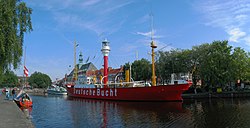Lightship Amrumbank
|
Lightship Amrumbank in Emden
|
||||||||||||||
|
||||||||||||||
|
||||||||||||||
|
||||||||||||||
|
||||||||||||||
|
||||||||||||||
The lightship Amrumbank was built in 1914/1915 by Meyerwerft in Papenburg / Ems on behalf of the Prussian Ministry of Public Works . As Amrumbank II in 1919 it became the successor to the later destroyed lightship Amrumbank .
career
The Amrumbank II was used as a manned lightship with 12 crew members who were on duty every 14 days. The motor ship, which was delivered in 1917, was laid out for the first time in 1918 for war measures in front of the mouth of the Eider , then from 1919 on at the Amrumbank station off the west coast of Schleswig-Holstein , where it was used with a brief interruption until 1939.
During its 65 years of service, the ship was anchored in different places until it moved to its last position, German Bight ( 54 ° 5 ′ N , 7 ° 26 ′ E ) in 1969 . This position information remained on the ship's sides even after the lightship was decommissioned. Its task took on 10 October 1983, first the light ship keel III , from 1986 then designed to slightly offset position bulk bin ( 54 ° 11 ' N , 7 ° 28' O ) and an unmanned boat fire .
The lightship today
On October 19, 1983, the ship was decommissioned and handed over to the association Museums-Feuerschiff Amrumbank / Deutsche Bucht eV by the Waterways and Shipping Directorate Northwest and converted into a museum ship in the branch canal in Emden , which can be viewed today in the Emden Ratsdelft .
The ship now includes a shipping museum on the port side. This museum was renovated in 2013, for the 30th anniversary, and redesigned by employees of the East Frisian State Museum Emden . In addition to the navigation sign technology, the history and development of the lightship Amrumbank, life and work on board, navigation and communication at sea are presented. Visitors also have the opportunity to tour the engine room. The Amrumbank engine is still fully functional and the ship leaves the Ems every year.
The former mess in the deckhouse was converted into a restaurant with a maritime flair. The rebuilt, but still fully functional bridge serves as the club room for the guest operations. In the former map room, the "German Amateur Radio Club" operates a radio station with the call sign DFØMF.
On the ship there is a wedding room of the registry office of the city of Emden. Official weddings are held in the captain's salon or on the bridge.
predecessor
The previous building, later called Amrumbank I , a steamship with reserve sails, commissioned by the same ministry through the Royal Water Works Authority of Husum , was built in 1906/07 and laid out on the then newly established position “ Amrumbank ”, where it remained until the First World War . Since the Amrumbank II came into service in 1919, the ship, now renamed Reserve Tönning , was used as a reserve fire ship until 1939. At the beginning of the Second World War , it became the Dow 124 , which served the Navy as a harbor protection boat until it was sunk in the Bay of Kiel in 1944.
See also
Web links
- Friends of the museum lightship “Amrumbank / German Bight” eV
- Sectional drawing and data of Amrumbank I
Individual evidence
- ↑ a b Lightship Amrumbank II . On July 7, 2009 from Leuchtturm-atlas.de, accessed on May 4, 2017
- ^ Lightship "Amrumbank I". feuerschiffseite.de, 2002, archived from the original on November 14, 2011 ; accessed on May 4, 2017 .
Coordinates: 53 ° 21 ′ 58 ″ N , 7 ° 12 ′ 23 ″ E

